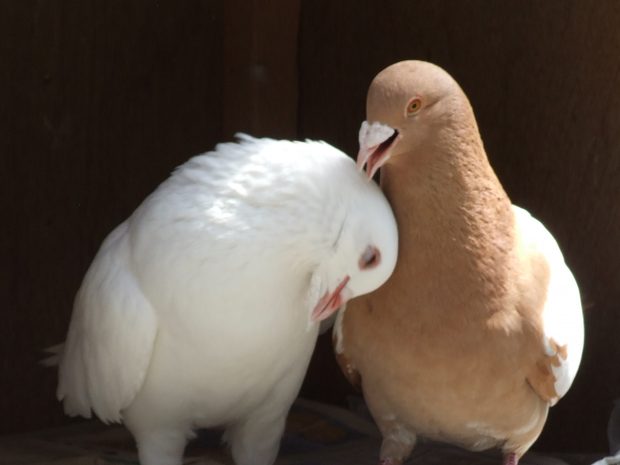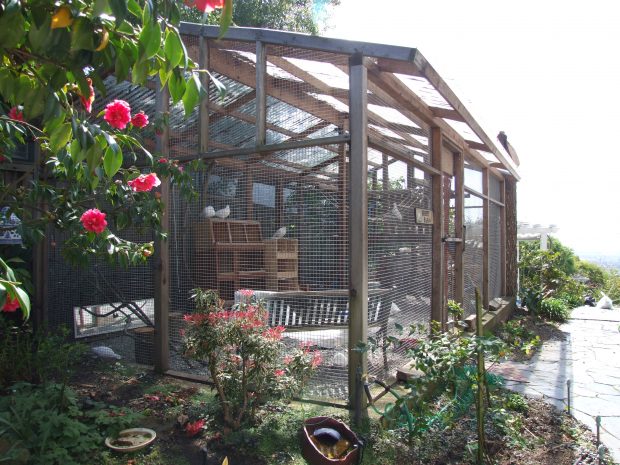Guest Post by Linda Press Wulf
I was never very interested in birds. I love dogs, I dream of galloping on my own horse, I bonded with my future husband over rabbits, we have fostered kittens. But birds don’t have names, or personalities, or lovability. So I thought.
When I first signed up with a new rescue association for pigeons that could not be released into the wild, my reasons were hardly persuasive. The rescued rabbits that we kept for years in a huge aviary-style outdoor cage had finally gone to the Big Carrot in the Sky. The aviary was empty, wasting.
We were tired of rabbits, didn’t want chickens, and weren’t prepared to take on any time-consuming pets. Then I heard about Elizabeth Young, who had committed herself to saving king pigeons. Kings are bred for eating in restaurants, called squab on the menu, so their breast meat is disproportionately large. As a result, they are slow fliers and easy targets for hawks. When kind-hearted people see the beautiful huge white pigeons for sale at Vietnamese and Chinese markets and buy and release them with good intentions, the birds’ “freedom” lasts only a few days and their death is horrible. There are other pigeons too that cannot be released into the wild, such as racing pigeons and “wedding-release” homers that have become lost and are no longer wanted by their owners, as well as some feral pigeons with injuries or who have been raised indoors and then abandoned. Elizabeth formed MickaCoo to rescue these birds, trying to find people who would foster them for a while or adopt them permanently. And there I was, with an unused aviary.
I committed to fostering for a few months. I am still fostering three years later, with a changing group of twenty to twenty-seven birds in my care. Some of my friends think I’m crazy, or at least eccentric, but if they will listen, I explain that the pigeons have been, other than dogs, the most interesting pets I’ve ever had, and compared with my other pets, especially dogs, they are the least trouble. Most days, I spend less than three minutes in the cage, simply filling their food and water bowls. I check for eggs, apologizing guiltily as I sneakily remove real eggs and replace them with wooden look-a-likes. (There are too many pigeons in need of rescue, so offspring are a big mistake – called Oops Babies.) The wooden eggs are accepted with grace, and the pigeon couples sit on them patiently for weeks – alternating duties between dad during the day and mom at night – until they decide that location, location, location is the problem, and they move to another hutch and start again. Other days I spend some time hosing off the gravel on the ground or changing the newspaper in their hutches. On the best days, I just sit and watch them, endlessly fascinated by their behavior.
Pigeons mate for life. Their courting, which is recognizable after you’ve seen it once or twice, takes from a few minutes to a few weeks, and then that’s it – they are committed. Unlike humans, the strong and the good looking do not feel entitled to the cream of the crop: their mating choices are inexplicable, but once made, that’s it. The next step is to choose a hutch, win it against any competitors, and build a haphazard nest of straw or twigs. Then the pressure increases. Males spends a huge and hilarious amount of energy chasing their fertile mates back to the nest. No time to eat, or explore, or stretch legs. Round and round the aviary, he chases her, little legs pumping, efforts to “duke” or bob or weave persistently thwarted. With single-minded determination, he chases her to their nest. Finally an egg is laid, followed the next day by a second.
Animal behaviorists have shown that pigeons can recognize faces, can do tricks, can even be taught to play a form of ping pong. I find it more interesting to watch the way they “kiss” for long moments, a movement that is actually a preparation for feeding a baby bird mouth-to-mouth. To watch mates grooming each other. To hear the soft, calming coo-ing that seems generic at first, but eventually reveals the individuality of each pigeon’s voice.
Elizabeth can tell all the birds apart, but most of the big white ones look the same to me, and I usually have to check the colored bands on their legs or observe where they are nesting and who they are nuzzling. Mackenzie is the one I know best, because he was my first bird, along with an unnamed female, whom I called Ichiban, Number One in Japanese. When they suddenly decided many months later that they were going to be a couple, I watched Mackenzie’s self confidence grow until he was lording it over all newcomers, chasing any rude youngsters out of the cubbies next to and above and below his love nest. Two good years later, Ichiban developed a large lump that made her wing stick out crazily. The avian vet diagnosed a cancerous growth, and Mackenzie accompanied Ichiban to a volunteer with more medical knowledge than I have, and a much smaller aviary. He stayed close to his mate as she grew more and more lopsided. When Ichiban died, it took a while before he paid any attention to the three females placed in his little aviary to distract him. Tomorrow he is coming home to me with his second mate. His original cubby has been usurped in his absence but I know Mackenzie better than I ever thought I would know a bird. He will choose a new place, guard it against any trespassers, settle down into being a faithful husband, boss his wife unmercifully, and recognize my face.
Thank you to Linda and the Wulf Family for their loving and life-saving care of 76 foster pigeons since 2010!
If you’d like to become a much needed foster volunteer, whether for a couple or many, please go here for more information.



